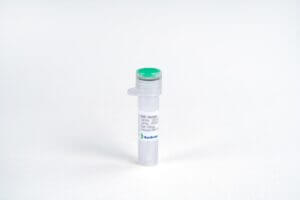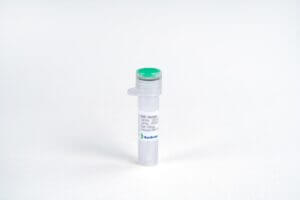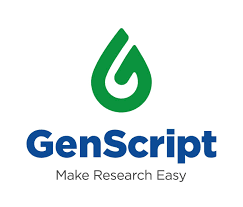100g
Showing 1101–1150 of 2169 results
-

ICOS Fc Chimera, Human
$301.88 Add to cart View Product DetailsInducible T-cell costimulator is an immune checkpoint protein that in humans is encoded by the ICOS gene. CD278 or ICOS (Inducible T-cell COStimulator) is a CD28-superfamily costimulatory molecule that is expressed on activated T cells. It is thought to be important for Th2 cells in particular. The protein encoded by this gene belongs to the CD28 and CTLA-4 cell-surface receptor family. It forms homodimers and plays an important role in cell-cell signaling, immune responses and regulation of cell proliferation.
-

Idebenone
$1,414.88 Add to cart View Product DetailsIdebenone
-

IFN-γ, Human
$99.19 Add to cart View Product DetailsHuman Interferon gamma (hIFN-γ) is amacrophage‐activating factor and the lone member of Interferon type II.The active form of IFN-γ is an antiparallel dimer that interacts with the receptor IFN-γR1 and sets off IFN-γ/JAK/STAT pathway. IFN-γ signaling does diverse biological functions primarily related to host defense and immune regulation, including antiviral and antibacterial defense, apoptosis, inflammation, and innate and acquired immunity. While IFN-γ–induced inflammatory cascade summons a variety of immune‐related cell types, such as macrophages, natural killer (NK) cells and cytotoxic T lymphocytes (CTLs), IFN-γ is also implicated in resistance to NK cell and CTL responses and in immune escape in a variety of cancers.
-

IFN-γ, Mouse
$86.25 Add to cart View Product DetailsSharing 41% sequence identity with human Interferon gamma (hIFN–γ), mouse IFN gamma (mIFN–γ)is a macrophage-activating factor.The active form of IFN–γ is an antiparallel dimer that sets off IFN–γ/JAK/STAT pathway. IFN–γ signaling does diverse biological functions primarily related to host defense and immune regulation, including antiviral and antibacterial defense, apoptosis, inflammation, and innate and acquired immunity.While IFN–γ–induced inflammatory cascade summons a variety of immune-related cell types, such as macrophages, natural killer (NK) cells and cytotoxic T lymphocytes (CTLs), IFN–γ is also implicated in resistance to NK cell and CTL responses and in immune escape in avariety of cancers.
-

IFN-γ, Rat
$163.88 Add to cart View Product DetailsInterferon-gamma (IFN-γ), also known as Type II interferon or immune interferon, is a cytokine produced primarily by T-lymphocytes and natural killer cells. The protein shares no significant homology with IFN-β or the various IFN-α family proteins. Mature IFN-γ exists as noncovalently-linked homodimers. It shares high sequence indentity with mouse IFN-γ (86 %). IFN-γ was originally characterized based on its antiviral activities. The protein also exerts antiproliferative, immunoregulatory and proinflammatory activities and is thus important in host defense mechanisms. IFN-γ induces the production of cytokines, upregulates the expression of class I and II MHC antigens, Fc receptor and leukocyte adhesion molecules. It modulates macrophage effector functions, influences isotype switching and potentiates the secretion of immunoglobulins by B cells. Additionally, IFN-γ augments TH1 cell expansion and may be required for TH1 cell differentiation.
-

Igepal(R) CA-720
$56.60 Add to cart View Product DetailsIgepal(R) CA-720
-

IGF-I, Salmon
$232.88 Add to cart View Product DetailsInsulin-like growth factor 1 (IGF-1), also called Somatomedin, is a hormone similar in molecular structure to insulin but has a much higher growth-promoting activity. IGF-1 consists of 70 amino acids in a single chain with three intramolecular disulfide bridges. IGF-1 may be a physiological regulator of [1-14C]-2-deoxy-D-glucose (5DG) transport and glycogen synthesis in osteoblasts. It is able to stimulate glucose transport in bone-derived osteoblastic (PyMS) cells and is effective at much lower concentrations than insulin, not only regarding glycogen and DNA synthesis but also with regard to enhancing glucose uptake. It may also play a role in synapse maturation.
-

IL-17D, Human
$301.88 Add to cart View Product DetailsIL-17D is a secreted cytokine with homology to the IL-17 family of proteins. It is preferentially expressed in skeletal muscle, brain, adipose tissue, heart, lung, and pancreas. It has been reported that IL-17D has the ability to stimulate the production of other cytokines from target tissues such as endothelial cells, treatment of endothelial cells with purified rIL-17D protein stimulated the production of IL-6, IL-8, and GM-CSF. In addition, rIL-17D also demonstrated an inhibitory effect on hemopoiesis of myeloid progenitor cells in colony formation assays.
-

Imidazole
$35.34 Add to cart View Product DetailsImidazole
-

Imidazole, Reagent
$62.45 Add to cart View Product DetailsImidazole, Reagent
-

Iminodiacetic Acid
$112.76 Add to cart View Product DetailsIminodiacetic Acid
-

Imipramine Hydrochloride, USP
$1,401.19 Add to cart View Product DetailsImipramine Hydrochloride, USP
-

Indanthrone, (Water soluble)
$258.65 Add to cart View Product DetailsIndanthrone, (Water soluble)
-

Indene, Stabilized with tert-Butylcatechol
$107.38 Add to cart View Product DetailsIndene, Stabilized with tert-Butylcatechol
-

Indigo Carmine
$286.45 Add to cart View Product DetailsIndigo Carmine
-

Indigo Carmine, Reagent, ACS
$311.78 Add to cart View Product DetailsIndigo Carmine, Reagent, ACS
-

Indigo, Synthetic
$203.61 Add to cart View Product DetailsIndigo, Synthetic
-

Indium-Tin Oxide, -325 Mesh
$1,401.88 Add to cart View Product DetailsIndium-Tin Oxide, -325 Mesh
-

Indole
$76.95 Add to cart View Product DetailsIndole
-

Indole-3-butyric Acid
$724.09 Add to cart View Product DetailsIndole-3-butyric Acid
-

Indomethacin
$225.84 Add to cart View Product DetailsIndomethacin
-

Inosine 5′-Monophosphate Disodium Salt, Hydrate
$1,233.36 Add to cart View Product DetailsInosine 5′-Monophosphate Disodium Salt, Hydrate
-

Inositol, FCC
$148.24 Add to cart View Product DetailsInositol, FCC
-

Inositol, NF
$191.00 Add to cart View Product DetailsInositol, NF
-

Inositol, Reagent
$52.44 Add to cart View Product DetailsInositol, Reagent
-

Inulin
$473.26 Add to cart View Product DetailsInulin
-

Iodine Monochloride, Reagent, ACS
$689.62 Add to cart View Product DetailsIodine Monochloride, Reagent, ACS
-

Iodoacetic Acid Sodium Salt, Reagent
$1,257.94 Add to cart View Product DetailsIodoacetic Acid Sodium Salt, Reagent
-

Iodobenzene
$79.49 Add to cart View Product DetailsIodobenzene
-

Iodocyclohexane, (stabilized with Copper chip)
$405.00 Add to cart View Product DetailsIodocyclohexane, (stabilized with Copper chip)
-

Iodoethane, (stabilized with Copper chip)
$47.92 Add to cart View Product DetailsIodoethane, (stabilized with Copper chip)
-

Iodoform, Reagent
$260.65 Add to cart View Product DetailsIodoform, Reagent
-

Iodoform, Reagent
$1,111.03 Add to cart View Product DetailsIodoform, Reagent
-

Iodoquinol, Powder, USP
$221.70 Add to cart View Product DetailsIodoquinol, Powder, USP
-

Ipratropium Bromide, USP
$7,939.28 Add to cart View Product DetailsIpratropium Bromide, USP
-

Iron Metal, Electrolytic, Granular, Primary Standard
$240.29 Add to cart View Product DetailsIron Metal, Electrolytic, Granular, Primary Standard
-

Isatin
$122.38 Add to cart View Product DetailsIsatin
-

Isobutyl 4-Aminobenzoate
$334.20 Add to cart View Product DetailsIsobutyl 4-Aminobenzoate
-

Isobutyramide
$306.15 Add to cart View Product DetailsIsobutyramide
-

Isophthalic Dihydrazide
$112.30 Add to cart View Product DetailsIsophthalic Dihydrazide
-

Isopropyl Carbamate
$468.18 Add to cart View Product DetailsIsopropyl Carbamate
-

Isopropyl Chloroformate, (ca. 30 Percent in Toluene, ca. 2mol/L)
$51.75 Add to cart View Product DetailsIsopropyl Chloroformate, (ca. 30 Percent in Toluene, ca. 2mol/L)
-

Isopropyl-beta-D-thiogalactoside, High Purity
$4,826.67 Add to cart View Product DetailsIsopropyl-beta-D-thiogalactoside, High Purity
-

Isosorbide
$68.15 Add to cart View Product DetailsIsosorbide
-

Isovanillin
$290.41 Add to cart View Product DetailsIsovanillin
-

Itaconic Anhydride
$135.01 Add to cart View Product DetailsItaconic Anhydride
-

Itraconazole, Micronized, USP
$1,616.54 Add to cart View Product DetailsItraconazole, Micronized, USP
-

Jack Bean Meal, Powder
$254.63 Add to cart View Product DetailsJack Bean Meal, Powder
-

Kanamycin Sulfate
$575.36 Add to cart View Product DetailsKanamycin Sulfate
-

Keratin, Powder
$648.91 Add to cart View Product DetailsKeratin, Powder






